Situated less than two miles apart, Whitehills and Macduff have a longstanding association with fishing in the Moray Firth, reports David Linkie
Little more than a generation ago, both Whitehills and Macduff were home to a thriving fleet of inshore seine-netters that landed daily to busy local markets.
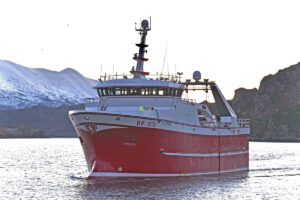
Endeavour V arrives at a wintery Kinlochbervie for the first time, to land 1,900 boxes of whitefish from a successful maiden trip. (Photo: Kevin Munro)

Three single and twin-rig trawls are worked from a full-length trawl deck in conjunction with six sweepline winches and three elevated bagging drums.

General view of the highly automated fish-handling system, which includes a KM Mk II gutting machine.

The MaK main engine and Caterpillar gensets.
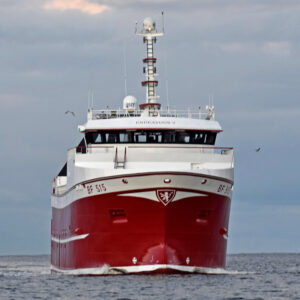
Endeavour V approaching Kinlochbervie. (Photo: Kevin Munro)

Fish from Endeavour V’s maiden trip laid out for sale on Kinlochbervie market. (Photo: Kevin Munro)

A video wall is positioned across the front…

… of the spacious wheelhouse.

A day room is arranged forward of the messdeck and galley on the starboard side at main deck level.

A central island enables crewmen to clip chain pennants on and off the middle clump.

Port quarter view of Endeavour V.

Two views of the crew’s…

deck change wardrobe.

A walk-in instrument room is located directly below the wheelhouse.

Endeavour V’s spacious…
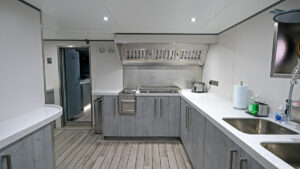
… and well-equipped galley

The twin-table messdeck.

Endeavour V recorded an average top speed of 13 knots on Class engine endurance trials.

Outhauling the twin-rig extension sections off the outer bagging drums, which are positioned above the trawl deck.
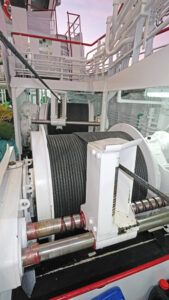
The split winches for the middle and starboard wires are mounted midway along the trawl deck.

Single and twin-rig hopper trawls are worked from three sets of sweepline winches mounted forward on the shelterdeck.

Outhauling the starboard codend from the bagging drum.
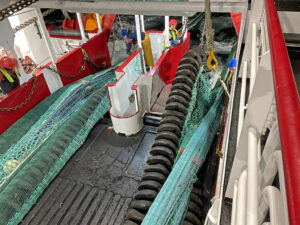
Crewmen working from the safety of the central island platform while shooting away the twin-rig hopper trawls.
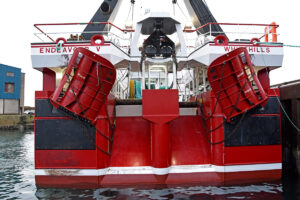
Stern view of Endeavour V.

Endeavour V is the largest vessel built to date by Macduff Shipyards.

The MaK 8M20C main engine delivers 1,080kW @ 900rpm.

Twin Caterpillar C9.3 auxiliary engines drive 250ekW generators.

Two 55kW electro-hydraulic power packs operate the split trawl winches when towing, and provide full net-retrieve facilities.

Twelve selection bins are arranged above the main selection/gutting conveyor.

An elevated conveyor leads fish forward from the washing compartments…
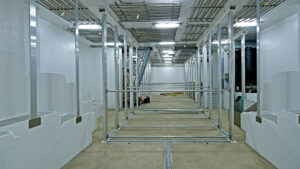
… for delivery to the fishroom.

Machinery for the safe liquid-based refrigeration system installed by Airo-Tech in a dedicated compartment…

… serves the deckhead and underfloor chilling systems in the fishroom.

One of the Buus 4.5t flake ice machines can also deliver slush ice.

Endeavour V.

Endeavour V’s central island navigation/fishing console is positioned aft…

… of the main quad-view video wall installed by Woodsons.

The fishing console.
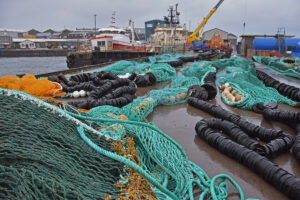
Single and twin-rig hopper trawls from Jackson Trawls laid out on the quay at Fraserburgh, ready to be pulled aboard Endeavour V.

Shooting away the 120ft twin-rig hopper trawls.

Endeavour V uses a set of Vónin Storm 4.5m2 trawl doors to spread the gear.

A Morgère twin-sphere 2.5t roller clump ready to be taken aboard Endeavour V.

The first Endeavour was built by Macduff Shipyards in 1989…

… followed by Endeavour II in 1993…

… Endeavour III in 1996…
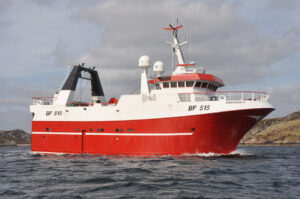
… and Endeavour IV in 2009.
Although times have changed dramatically in the past 40 years, today the local communities, together with those of neighbouring Banff and Gardenstown, form a nucleus that is vitally important to the Scottish fishing industry.
A significant proportion of Scottish vessels are owned by local skippers, who continue their families’ proud association with fishing by consistently investing in new vessels.
As well as being a well-known focal point for vessel refits, Macduff harbour is home to one of the UK’s main boatbuilders.
The completion of Endeavour V, which at 34m LOA has the distinction of being the biggest boat built to date by Macduff Shipyards, further strengthens the area’s reputation and the close-knit and multi-generational fishing bonds that are its lifeblood.
Owner and builder loyalty, based on decades of mutual benefit, are showcased by the fact that Endeavour V is the fifth boat of the same name that Macduff Shipyards has built for the Whitehills owners since 1989.
Endeavour V also continues the longstanding connection between Whitehills and Kinlochbervie. Although situated some 200 miles northwest by road, Kinlochbervie has strong links with Whitehills and Macduff.
The success of a series of wooden-hulled single and pair-trawlers built at Macduff for local skippers in the 1970s and 1980s played a significant role in the rapid growth of Kinlochbervie as one of the leading whitefish ports in Scotland. This led to the construction of a new deepwater harbour, navigation channel and fishmarket that three decades later meet the requirements of Endeavour V, which landed her maiden trip at Clash last month.
Having fished from Kinlochbervie for virtually all of a fishing career spanning nearly 40 years, skipper Peter Lovie said: “It is pleasing that two small fishing communities have continued to benefit each other during a period of dramatic changes. In many respects this summarises the philosophy behind Endeavour V.
“When the possibility of a new build was first discussed in the summer of 2017, we already knew that the vessel would be built at Macduff, such is the quality of end product that they deliver. Similar thinking applied to the choice of engineroom equipment, deck machinery, wheelhouse electronics and fishing gear, with preference being given to suppliers and service companies who have stood us in good stead down the years.
“While it is not always obvious to all, progressive continuity is a key part of fishing. Endeavour V represents a strong statement of intent for small coastal communities. Our crew of 10, which includes my sons David, Ryan and Andrew, who started their fishing careers immediately on leaving school, are all from Whitehills, Buckie and Kinlochbervie.
“That Endeavour V has a young crew is particularly satisfying, not least because they have worked extremely hard to get their required certification. Such levels of dedication and determination are of paramount importance to small coastal communities.
“Endeavour V is built for the future and the next generation, so it is a major concern that the Brexit deal as it stands brings no joy for young fishermen, nor local communities. The Brexit deal is extremely disappointing, as it hasn’t delivered what was promised.
“It was widely hoped that Brexit would have brought a reduction in the vast foreign effort in our Scottish waters, and a fairer share of fishing opportunities for the next generation and the future of our industry, which our coastal communities depend on.
“Seeing Endeavour V gradually becoming a reality less than two miles from home is a unique and extremely rewarding feeling.
“The end result speaks for itself and is a fitting tribute to everyone who contributed to the project, which for the last eight months was completed in the face of a global pandemic. Clearly this created unexpected challenges, including the yard being closed initially, but the Macduff Shipyards team dealt with these with their renowned can-do approach.
“The first three trips on our traditional grounds northwest of Scotland went smoothly from the first tow, with all systems and equipment, including fishing gear, performing well. Early indications are that Endeavour V will be a very capable boat, and one that will meet the requirements of fishing in the challenging North Atlantic in years to come.”
Crew and vessel safety considerations were of paramount importance throughout the design and build project. As a result, safety features range from a state-of-the-art vessel monitoring and control system and a gas-free fishroom refrigeration system to a Compact gangway manufactured by MMG Welding of Killybegs and a QuikSling MOB recovery sling.
Endeavour V is expected to fish eight- to nine-day trips in the North Atlantic west of Scotland for most of the year, including the deepwater grounds and Faroe, Rockall and Shetland waters.
Endeavour V’s whitefish catches will be placed in boxes supplied by Box Pool Solutions before being agented through the Kinlochbervie Fishselling Company and Don Fishing. Depending on where Endeavour V has been fishing, Kinlochbervie is expected to be the main port of landing, followed by Ullapool and Scrabster, from where catches will probably be consigned for sale on Peterhead fishmarket.
The vessel is insured by Sunderland Marine.
General layout
Of round bilge form, the hull of Endeavour V incorporates a streamlined bulbous bow, flared stem, ballast box keel, deep V-bilge keels and a roll reduction tank. The vessel’s full beam is carried full-length to the stern, where twin net ramps are separated by a central work island to assist the crew when clipping pennants and sweeps to the middle clump.
With main dimensions of LOA 34m, length BP 30.25m, beam 10.50m and depth moulded to trawl deck 7.25m (main deck 4.90m), the hull was fabricated under subcontract by Finomar shipyard in Szczecin, Poland, before being lifted into the water and towed to Macduff for all machinery installation and full internal outfitting by Macduff Shipyards to MCA and BV regulations.
Endeavour V features three full-length decks: main – accommodation and catch-handling system; shelter – gear-handling activity, main deck machinery, ice machine compartments and accommodation; and forecastle deck – accommodation, electronics room, protection for trawl deck, mounting of ancillary deck machinery, roll reduction tank and forward mooring winch room. The arrangement is based closely on that of the successful Endeavour IV, which proved itself well over the years, but makes use of the additional space to increase crew comfort, fish-hold capacity and working deck areas.
Layout below the main deck consists of the forepeak, in which three large freshwater tanks, used for ice-making duties, and the bow thruster compartment are housed; fishroom, with two double bottom fuel tanks; engineroom/control room; and aft peak, which features numerous tanks used to house both freshwater and ship’s services, such as lubrication and hydraulic oil.
Above the main deck, the vessel is generally divided along the centreline, with working areas to port and accommodation to starboard. To port, there is a steering gear compartment combined with an engineer’s workshop aft, the fish-handling area amidships and a dry locker forward. To the starboard side, there is a laundry/provisions store, fridge/freezers and galley aft, large mess/lounge amidships, and four two-man cabins forward. A large 20m3 hopper is arranged on the centreline.
The shelterdeck features the trawl deck, where most of the deck machinery is positioned. The deck has twin ramps aft, with hydraulically operated stern gates fitted to the top of each ramp for crew protection. Forward of these are two flush-fitted hopper hatches where the catch is taken onboard. The deck is then open all the way to the stem, where three split sweep winches are fitted to allow maximum deck length for storing and mending nets. Fitted amidships immediately above the net tracks are three separate bagging winches.
Three split winches are fitted amidships, two to starboard and the third to port, and lead directly aft to large trawl blocks. These are capable of moving forward up to 1.2m from the transom to alleviate the pressure on the steering gear when towing an edge in deep water.
Continued upwards from the hull sides, the main stern gantry is positioned just forward of the twin stern ramps, with the port leg housing the engine exhausts. The lower and narrower Gilson gantry is situated immediately abaft the wheelhouse.
Numerous casings are fitted either side of the tracks, and serve various functions such as net ponds and cage, air-handling unit room, two-man cabin and landing trunk.
The fo’c’sle deck runs from stern to stem. Aft it is mainly open, and provides a walkway around the perimeter of the trawl deck, as well as shelter for crewmen working on the trawl deck. Amidships features a full-breadth casing where three two-man cabins are fitted, along with an electronics room. Forward is arranged for mooring and anchoring, and features a three-barrel winch, fitted within a weathertight compartment and used to stow the two anchor warps, along with a spare barrel for mooring rope. The hull sides forward are continued upwards above the level of the fo’c’sle deck, to effectively give a deeply recessed whaleback.
A bridge deck is fitted above the shelterdeck, where the large wheelhouse is situated. This is nearly the full breadth of the hull, to provide excellent visibility when manoeuvring in restricted areas. Large windows are also fitted aft on the centreline, and provide a commanding view of the trawl deck to enhance crew safety.
The quality of internal fit-out, in which modern coloured laminates and grey planking floor coverings are widely used, can only be described as superb, further strengthening Macduff Shipyards’ already high reputation for internal finish.
A few weeks before Class trials were scheduled to be conducted, Endeavour V steamed from Macduff to Peterhead, where the trawler was lifted out of the water and rolled into the shiphall. The vessel was fully painted from the top of the mast to the keel by Davidsons Marine and Industrial Painters using a paint system supplied by PPG Protective and Marine Coatings.
Engineroom
Good use has been made of the space available in the aft engineroom of Endeavour V, to give drivers Andrew Lovie and Donald Morrison maximum ease of access for all levels of service in years to come.
Since Endeavour V arrived at Macduff in October 2018, the boat’s engineers liaised closely with the shipyard and other service provider teams on the engineroom layout.
Achieving optimum levels of fuel efficiency, from both the main propulsion and auxiliary engine systems, featured strongly in the design and planning stages of Endeavour V.
The choice of propulsion package was made easier by the economical performance of the combination of MaK engine and Mekanord gearbox during 11 years of consistently reliable service on Endeavour IV, and on Venture III since 2017.
The MaK propulsion unit and two Caterpillar C9.3 auxiliary engines were supplied by Finning UK and commissioned by Trevor McDonald (Marine Engine Services) Ltd.
The eight-cylinder MaK 8M20 main engine delivers 1,080kW @ 900rpm and is coupled to a Mekanord 650HS 6.47:1 reduction gearbox to turn Helseth stern gear and a 3,300mm-diameter four-bladed CP propeller. Supplied by BT Marine Propellers, the low-drag high-thrust nozzle incorporates a triple rudder system to provide high turning force.
This centreline combination, together with the new hull form, enabled Endeavour V to return an impressive average top speed of 13 knots on Class engine trials from Peterhead. Engine, gearbox and propeller settings are controlled from the wheelhouse using a three-station Noris Automation GmbH system supplied and installed by Trevor McDonald (Marine Engine Services).
Scan MT5000 steering gear, complete with carrier bearing, is fitted on the main deck below the ramp area.
The main hydraulic system on Endeavour V is driven by three double vane pumps from separately clutched PTO units fitted on the Mekanord gearbox, which is also fitted with a stand-by lube oil pump.
When towing, hydraulic power to the split trawl winches is provided by two electrically driven triple vane pumps that also provide landing and net-retrieve facilities.
Two electrically driven 55kW towing pumps, which can also be used for emergency gear retrieval, are also fitted. This arrangement enables the deck machinery to be operated in harbour when the crew are either mending or taking on gear, while the main engine is stopped for routine maintenance work.
Two Caterpillar C9.3 generator sets each delivering 250ekW provide 415/3/50 electrical supplies on Endeavour V.
The electrical generators are fully synchronised through the switchboard panels to give load-sharing and automated auxiliary start-up. The electrical switchboards and wiring, together with the galley equipment, were supplied and installed by RD Downie of Fraserburgh.
The requirement for Endeavour V to be built to Class, as well as her general size, made this a much bigger job than Downies had undertaken on any other vessel.
Downies and NU Design Ltd of Peterhead made the control room switchboard, which took 18 months from start to finish. Everything in the switchboard is controlled by a state-of-the-art touchscreen system designed by Pete Buchan of NU Design. There are also touchscreens in the engineer’s cabin and wheelhouse, so that everything can be monitored.
A fuel and water tank monitoring system built into the system has proven to be very accurate, even in poor weather.
The final product is ‘fantastic’, said engineer Andrew Lovie, who expressed the owners’ appreciation for the quality of work carried out by both companies involved.
Other main items of engineroom machinery include an oily water separator supplied by Goltens UK Ltd, a FlowScan fuel monitoring system, two CC Jensen fuel meters and an Azcue fuel transfer pump.
Hydraulically driven 186kW bow and stern thrusters supplied by Kort Propulsion are also fitted. Positioned above the propeller shaft, the stern thruster is a first for Macduff Shipyards. By enhancing safety and manoeuvrability, this new feature is already proving invaluable, due to the size of the vessel.
Two hydraulically operated gates topped with large-diameter rollers are fitted at the head of the stern ramps, astern of two similarly operated flush shelterdeck hatches that serve a large single fish hopper. This is fitted with internal baffles to minimise fish damage in heavy weather.
Fish-handling and catch storage arrangements
After being released from the codend into the hopper, an elevated conveyor moves fish from the vessel’s centreline towards the port side, where it is transferred onto the selection conveyor. This extends forward along most of the length of the central catch-handling area.
After gutting, fish are placed into one of 12 stainless steel selection bins located above and inboard of the main conveyor. In order to enhance catch quality at every stage of the handling process, fish are released from the selection bins into one of three integral washers, from which they are transferred onto another conveyor.
A separate tray is used to lead smaller fish selections across to a Kronberg Mk II gutting machine, supplied by Seagate Fabrication Ltd of Peterhead, from which they are delivered to a dedicated fourth washer.
Before being delivered by chute to a receiving tray in the fishroom, all selections of whitefish receive a final wash as they pass under a spray bar fitted above the delivery conveyor.
The ’tween deck fish-handling area is fitted with four sumps, each served by Azcue vertical vortex motor-driven pumps.
The large fishroom has a working capacity of up to 2,200 stacking boxes, supplied by Box Pool Solutions.
Optimum levels of refrigeration are delivered by a combination of chilling pipes fitted on the underside of the main deck, and underfloor chilling pipes laid into the sub-floor. Supplied by Ryan Summers of Airo-Tech Solutions Ltd, Fraserburgh, the fish hold refrigerant system is liquid-based. This poses no danger to life if a leak occurs, and can be easily mended onboard.
With refrigeration gas rules changing over the past 10 years, the owners decided to travel to Denmark to see glycol hold chilling, the use of which is well established on Danish boats. These systems operate with no gas in the fishroom and run at low pressure, making them totally safe. The refrigeration pipes on the deckhead are arranged in three sections, enabling one to be isolated should any issues occur.
Ten tonnes of flake ice – made by two 4.5t Buus ice machines housed in a dedicated room on the port side of the main deck, aft of the accommodation casing – can be stored in full-height lockers in the fishroom.
Production from one of the Buus ice plants can be switched from flake to slush ice simply by sliding a Perspex plate into position, so that the product is delivered to a small tank to be mixed with saltwater. The resulting slush ice is then automatically delivered to a 1.5t storage cylinder in the fishroom positioned forward of the flake ice locker. From this tank, slush ice is delivered by a combination of fixed and flexible pipes directly to where boxing is taking place.
The use of slurry ice, which flows freely into all cavities among stored fish to provide rapid chilling, enhances the quality of fish and shelf life. The owners anticipate that the availability of slush ice will be of particular benefit when they are targeting squid at Rockall in the early summer.
On arrival in the fishroom, all fish are weighed, recorded and labelled by a VCU Catch Management system, with the information being forwarded to a computer in the wheelhouse.
Collaboration delivers new hull form
The Endeavour V project started three and a half years ago, with fuel efficiency, safety, crew comfort, service speed, carriage and seakeeping being key priorities for the owners.
An early study by Macduff Shipyards and Macduff Ship Design concluded that to achieve these aims, a longer hull form, free from the constraints of registered length (sub-24m) and built to Class, would likely be required.
It was at this point that the yard reached out to the Wolfson Unit MTIA, based in Southampton, and an initial trial was carried out using computational fluid dynamics (CFD) technology to assess the differences in calm water hull resistance between the existing model and a new longer concept model.
As expected, the data showed that a significant reduction in hull resistance would be achieved with a longer hull form. However, the CFD-based analysis could not assess the difference in seakeeping qualities. To answer this question, the Wolfson Unit conducted a further trial, this time towing scale models in the Solent University Towing Tank facility.
Both hull forms were assessed at a range of speeds in both calm water and head seas, with wave properties reflecting those found in the North Atlantic, where the new vessel would generally operate. As well as confirming the reduction in resistance between the two hull forms, the tank testing also enabled seakeeping to be measured, and it was determined that the longer hull experienced considerably less pitching motion, along with lower bow impact from wave force.
With the Wolfson Unit’s work complete, the yard and Macduff Ship Design undertook one final review of the hull form, and the decision was made to lengthen the hull by another metre to achieve further improvements in hull efficiency, as well as affording a little more space within the vessel.
With the hull lines faired and stability assessed by Macduff Ship Design, the construction plans were then drawn up and submitted to Bureau Veritas classification for approval, along with the outfitting and engineering drawings. These were then supplied to Finomar shipyard in Szczecin, Poland, which was subcontracted to fabricate the hull and wheelhouse.
350t of MacGregor hauling power
MacGregor (GBR) Ltd supplied Endeavour V’s extensive package of deck machinery and designed the hydraulic system, thereby continuing the owners’ long association with the Peterhead company.
Twenty-two MacGregor units with a combined hauling power of some 350t ensure that Endeavour V has the capability to handle the heavy single and twin-rig hopper gear with maximum levels of efficiency and safety.
Three two-speed split trawl winches are situated just aft of amidships on either side of the full-length net tracks on the shelterdeck. The over-spooled winches for the outer wires have a core pull rating of 28.9t, and a capacity for 2,250m of 26mm-diameter wire. Positioned forward and slightly higher than the starboard winch, the middle wire unit has a similar drum capacity with an increased first layer rating of 30.9t.
The winches operate through a PTS-Pentagon CbusHF system, through which the electric/hydraulic pumps are automatically controlled.
The hanging blocks for the outer wires are mounted under the boat deck on either side of the stern ramp, while the middle wire leads over the top of the starboard winch to a block suspended from a dedicated gantry atop the wrap-round boat deck.
The position of the outer hanging blocks in relation to the stern can be adjusted by up to 1,200mm by the use of hydraulic rams operated remotely from the fishing console in the wheelhouse. This feature is designed to increase the turning capability of Endeavour V when towing, by taking the fulcrum point forward, closer to the fixed nozzle and triple rudder system.
Three single/twin-rig whitefish hopper nets are hauled along the full length of the trawl deck by three 2 x 19.4t split sweep winches. The middle split sweep winch, from which the single net will usually be worked, is located forward of the port and starboard units.
Three 12.5t bagging drums span the boat deck aft of the wheelhouse to assist with hauling the tunnel section of the trawls.
The codends are hauled up the stern ramps using Dyneema chokers by two 13t Gilson winches positioned at boat deck level immediately aft of the wheelhouse. The choker ropes are positioned on the trawls so that when they are clipped onto the Gilsons, the codends are hauled up the stern ramps in a oner.
When the bags are clear of the stern ramps, the two hydraulically operated ramp gates are raised, followed by the similarly operated twin hopper hatches. Two 10.3t winches mounted on the transom boat deck are then used to raise the codends, before the fish are released into the 20m3 capacity hopper.
Two outhaul winches are mounted on the underside of the boat deck across the stern to assist in shooting the trawls away.
Stacks of boxes in the fishroom are pulled towards the landing hatch by a 3t winch.
Endeavour V’s main hydraulic system is operated by three double vane pumps (1 x 208kW @ 1,584rpm and 2 x 197kW) driven from separately clutched PTO units fitted on the Mekanord gearbox.
When towing, hydraulic power to the split trawl winches is provided by two electrically driven triple vane pumps (55kW @ 1,470rpm) that also provide landing and net-retrieve facilities.
Operation of the electric/hydraulic pumps is one of the functions performed by the PTS-Pentagon CbusHF autotrawl system, the control panel for which is mounted in the fishing console in the wheelhouse.
SeaQuest crane first
SeaQuest Systems of Killybegs supplied the 2.3t @ 12m knuckle-boom landing crane mounted on the port boat deck. It has the distinction of being the first the Killybegs specialist has supplied to Macduff Shipyards, and the first to be installed on a Scottish whitefish vessel.
As is customary for SeaQuest cranes, all hinge pins, cylinder rods, hydraulic fittings and pipework are manufactured in stainless steel, while all other parts were shotblasted and metalised before painting.
Incorporating a 2.5t winch, the deck crane can also be used to handle the trawl gear, in addition to discharging catches at the end of a trip. Two independent HPU units power the crane and landing winch so that other jobs can be done in harbour while landing.
High-end electronics equipment in streamlined wheelhouse
On entering Endeavour V’s wheelhouse, the first impression is of space and orderliness, enhanced by the same understated level of finish that is evident throughout the boat.
The owners and yard placed the emphasis fairly and squarely on a clean and uncluttered wheelhouse interior, made possible by ever-advancing electronics technology.
A single skipper’s chair, supplied by E Vejvad Hansen of Esbjerg, is positioned on the vessel’s centreline at the head of a U-shaped console, in front of three 55in 4K bridge monitors. Slightly angled into each other, these three units form a quad-view video wall operated through an integrated touchscreen control system developed and installed by Woodsons, which supplied a full package of electronic equipment.
Another seven Neovo X24 widescreen and two AG Neovo X15 monitors are located in the overhead forward console and around the central trawling console aft.
Slim wing steering consoles are arranged towards the forward corners of the wheelhouse.
A desk area housing the E-Catch reporting computer is positioned in the forward starboard corner. A raised seating area and adjoining table are arranged in a similar area to port.
Hot drink-making facilities, together with a built-in fridge and sink, are to hand in the aft port corner.
Fish-finding and sizing functions are performed by two Kaijo KSE310 dual-frequency (38/70kHz) split-beam echosounders. The Kaijo units are well proven in the detection of marks, and accurate calculation of the size of fish within them, utilising their unique 144-element transducer creating 15 separate beams.
The location of Endeavour V is displayed at all times on two Sodena Easywin plotting systems alongside an Olex 3D seabed mapping system, all of which are interfaced to give a combination of AIS/ARPA, wind, tidal and chart overlays.
Two Sailor 6560 GNSS GPS navigators process details of Endeavour V’s position. Vessel heading is provided by Type-approved JRC JLR-21 satellite and Simrad GC80 gyro system compasses.
Both the JRC JMA-5410-6X and 5206-4 BB sets provide radar and AIS tracking, both within the radars themselves and also interfaced to the plotters.
Steering is handled by a Simrad AP70 Mk 2 autopilot system with three joystick control sets.
The mandatory GMDSS communications required for the areas where Endeavour V will fish include a Sailor 6310 MF/HF 150W radiotelephone, Sailor 6222 Class A DSC VHF, two Sailor SP3520 handheld GMDSS VHFs, JRC NCR 333 Type-approved Navtex, Jotron Tron 60S GPS EPIRB and Jotron Tron Sart 20.
Additional communications equipment includes two Sailor 6210 VHFs, Phontech 3102 20-way talkback system, Iridium Pilot communications system, and e-SEA 60Ka internet and e-SEA 80 satellite TV systems.
Woodsons also installed an extremely comprehensive CCTV system that utilises 25 cameras and an underwater camera constantly monitoring the propeller, nozzle and triple rudder.
Scanmar net- and catch-monitoring
Single and twin-rig trawling efficiency on Endeavour V is optimised by the latest range of Scanmar net-monitoring receivers, software and sensors, supplied, installed and commissioned by Scanmar UK of Peterhead, which has a longstanding association with the owners.
Scanmar’s new-generation WDR-42 receiver, complete with 365 modular software, is installed on Endeavour V. A new modular platform, 365 allows the user to pre-set up to six individual screens according to fishing type, ground type and target species. This has proved to be a great success, with skippers enjoying the option of changing the overall layout of the Scanmar system based on their specific needs.
The new WDR-42 receiver constantly supplies updated data from all Scanmar sensors.
Mounted on the Vónin Storm trawl doors are Scanmar SS4 Double Distance sensors complete with door-angle functions (door pitch and roll).
A temperature function has been installed into the starboard door sensor which provides real-time temperature readings on the seabed, enabling the skippers to pick up and follow thermoclines that proved productive on previous tows, data from which can be stored to build up historic track record.
The SS4 clump sensor is mounted on the Morgère clump, providing readings of distance from door to clump on both sides, together with overall door spread.
On the port trawl, a Scanmar TrawlEye headline sounder is mounted on the headline, providing information on the headline height from the top of the trawl to the seabed, the opening of the trawl from footrope to headrope, and clearance from seabed to footrope.
The density of fish at the mouth of the trawl is displayed with a value from zero to nine, and colour density.
An SS4 catch sensor is mounted on the codend to maximise fishing effort and reduce costs.
On the starboard trawl, a Scanmar Trawl Sounder headline sensor provides similar information to the TrawlEye sensor, complete with an SS4 catch sensor mounted on the codend.
A Scanmar flow sensor is mounted alongside the TrawlEye on the port headline to provide not only ‘water speed’ through the trawl but also ‘symmetrical information’ to allow adjustments to be made to the port, starboard or middle warps to achieve trawl symmetry.
The new Scanmar SCU control unit enables a skipper to click and drag each sensor on the modular display. In addition to timesaving, it also avoids frequency collision by automatically making any necessary changes.
Peterhead netmaker supplies full gear package
Jackson Trawls supplied a full package of fishing gear and trawl chandlery to Endeavour V.
When twin-rig trawling, Endeavour V tows two 120ft trawls rigged on 16in- and 18in-diameter hoppers. With 575 6¼in meshes in the fishing circle, the nets are built with 3.1mm Sapphire twine in the top sections. Magnet compact green netting was used in the bottom section, and magnet compact yellow in the taper sections of the bag.
The extension sections are made from 5mm double magnet green netting, while 5mm double Sapphire was used for the codends.
Although primarily designed for taking groundfish, a headline height of 3.5 fathoms effectively gives the twin-rig trawls dual-purpose flexibility for taking higher-swimming haddock. Built to give low maintenance, Endeavour V’s nets feature three tearing strips and double carflex selvedges to ensure quick mending at sea, and reverse yellow and blue Sapphire 5mm double 120mm and 140mm codends, with the latter being used when fishing in Faroese waters.
Jacksons also made a double-breasted single trawl rigged on 200ft of 18in hoppers. Standing slightly higher than the twin-rig trawls and with a longer tunnel, the single net features a Dyneema headline and 11in deepwater floats. With the equivalent of 590 6.25in meshes in the fishing circle, the single trawl is primarily intended for use in poor weather.
Jacksons also supplied complete sets of Dyneema Gilson, codend and sweeplines for Endeavour V as part of a full trawl chandlery package, along with three 2,000m lengths of 26mm-diameter Bridon Starfish Dyform trawl wire.
In placing their order for a full gear package with Jackson Trawls, which also included a comprehensive selection of spare gear, including chains and netting, the owners continued their long association with the Peterhead netmaker, which also supplies all fishing gear to Venture III BF 326.
Endeavour V uses a set of Vónin Storm 4.5m2 trawl doors and a Morgère twin-sphere 2.5t roller clump to spread the trawls, in conjunction with 60-fathom sweeps. From the trawl doors, these are made up of equal sections of 36mm heavy-wire single bridles and 19mm mid-link ground chains/18mm-diameter wire sweeps.
Trevor McDonald (Marine Engine Services) Ltd
A comprehensive Noris Automation GmbH vessel monitoring and alarm system, supplied and installed by Trevor McDonald (Marine Engine Services) Ltd, is one of the key features on Endeavour V.
The Ellon company also commissioned Endeavour V’s MaK main engine, together with the Caterpillar C9.3 gensets.
This level of involvement highlights Trevor McDonald’s longstanding relationship with the Endeavour V skippers, as well as with skipper Mark Lovie on Venture III, which is based on reliable technical service and 24/7 support.
Highly specialised control and management equipment manufactured in-house by Noris Automation GmbH is widely used in all forms of modern transport, including aeroplanes and trains. Noris systems, designed to meet a range of Classification types, are also used on a wide spectrum of commercial shipping, including cruise ships, tankers, container vessels and support vessels.
The monitoring and alarm system fitted on Endeavour V, together with the three-station gearbox and propeller controls, were developed in close liaison with the boat’s skippers and engineers. This ensured that the monitoring system was fully customised to the specific requirements of all concerned, as well as the vessel itself.
One example is that the propeller controls were configured so as to protect machinery and still permit excellent response and manoeuvrability of the vessel. The vessel’s skippers and engineers are highly impressed with the user-friendly aspect of both systems.
Pressures and temperatures across all machinery, including the ice machine and fishroom refrigeration, propeller pitch and electrical supplies are among the wide range of parameters constantly monitored by the Noris vessel management system on Endeavour V, and displayed in both the wheelhouse and the engineer’s cabin.
Fifth Macduff-built Endeavour
Completion of Endeavour V continues a long association between skipper Peter Lovie and Macduff Shipyards that stretches back over 30 years and encompasses five boats.
The first Endeavour BF 326, a 21m wooden-hulled single-rig whitefish trawler, was delivered in 1989. Equipped with a 399kW Deutz main engine and a three-quarter-length shelterdeck, Endeavour fished year-round from Kinlochbervie until Macduff Shipyards completed the 23m Endeavour II BF 515 in 1993.
Her predecessor was bought by James Lovie and renamed Enterprise BF 1, continuing to fish from Clash until being sold to Fraserburgh in 1999 and renamed Good Design BF 151. After she had fished from Newlyn as Crystal Sea SS 118, Gairloch skipper Angus Macleod brought the boat back to Scotland in March 2016, when she was renamed Fladda Maid UL 209.
Endeavour III, a 27.4m steel-hulled twin-rig trawler designed to spend more time fishing in deeper water to the west of Scotland, entered service in 1998, shortly after Endeavour II was renamed Venture BF 821 by Peter Lovie’s brother Mark Lovie, who had previously skippered the boat on alternate trips. Today, the vessel fishes from Shetland as Devotion LK 801.
Powered by a 900kW Caterpillar 3516 main engine, Endeavour III was sold to Icelandic trawling/processing company Rammi in 2008 and renamed Frodi I AR-38 as the 28.96m stern trawler Endeavour IV was under construction.
After 11 successful years, Endeavour IV was bought by Colin and Jon Mitchell and renamed Beryl BF 411 six months ago.
ENDEAVOUR V BF 515
DETAILS
Owner: Knockhead LLP, Whitehills
Designer: Macduff Shipyards Ltd (hull built under subcontract at Finomar shipyard, Szczecin, Poland)
Class: Bureau Veritas +1A1, fishing vessel, unrestricted navigation, dot MACH
Agent: Don Fishing Ltd
DIMENSIONS and CAPACITIES
Length overall: 34m; Length BP: 30.25m; Beam: 10.50m; Depth moulded: Trawl deck 7.25m; main deck 4.90m; Draught: 6.4m; Tonnage: 620t gross; Fuel: 90,600 litres; Freshwater: 46,500 litres; Water ballast: 23,600 litres; Roll reduction tank: 8,100 litres; Lube oil: 1,250 litres; Hydraulic oil: 1,250 litres; Fishroom: 2,200 boxes; 10t of ice
ENGINEROOM
Main engine: MaK 8M20C of 1,080kW @ 900rpm driving through a Mekanord 650HS 6.47:1 reduction gearbox to Helseth 4TZ750/240 stern gear and a 3,300mm-diameter four-bladed CP propeller; Speed: 13 knots
Auxiliary engines: 2 x Caterpillar C9.3 250ekW generators
Bow/stern thrusters: Kort Propulsion 186kW
Fuel and oil filters: 2 x CC Jensen
Bilge, deckwash, fish-handling and fire pumps: Azcue electrically driven
DECK MACHINERY
Supplier: MacGregor (GBH) Ltd, Peterhead and SeaQuest Systems Ltd, Killybegs –
2 x TWS-4521 28.9t and 1 x TWS-4521 30.9t split trawl winches, capacity 2,250m of 26mm-diameter wire; Rapp Marine autotrawl system PTS-Pentagon CbusHF; 3 x SW2300 split sweep winches 2 x 19.4t, capacity 2.79m3; 3 x ND1200 bagging drums 12.5t, capacity 4.2m3; 2 x GWB680 codend winches 10.3t, capacity 60m of 3,440mm-diameter rope; 2 x Gilson winches M25 13t, capacity 90m of 40mm-diameter rope; 2 x gantry winches H8 5.9t, capacity 50m of 12mm wire; 1 x forward gear-handling winch M12 7.7t, capacity 120m of 12mm-diameter wire; 1 x fishroom winch PL5 2.9t; 1 x AWW-1800 anchor mooring winch 5.5t; SeaQuest knuckle-boom deck/landing crane 2.3t @ 12m c/w 2.2t winch
FISH-HANDLING/FISHROOM
Fish-handling system: Macduff Shipyards; Fishroom chilling: Airo-Tech Solutions Ltd, Fraserburgh; Ice machines: 2 x 4.5t Buus flake ice machines, one of which has combined slush
ELECTRONICS
Suppliers: Woodsons, Aberdeen and Scanmar UK, Peterhead
Fish detection
2 x Kaijo KSE310 dual-frequency (38/70kHz) split-beam fish-sizing echosounders; Scanmar Scanbas 365 single/twin-rig trawl-monitoring system c/w SS4 distance and door angle sensors, 2 x catch sensors c/w angle and temperature, Scanmar TrawlEye headline sounder
Navigation
JRC JMA-5410-6XBB and JRC JMA-5206-4BB radars; 2 x Furuno GP-39 GPS receivers; Olex 3D seabed mapping system; 2 x Sodena Easywin plotting systems; Simrad AP70 autopilot system; Simrad GC80 compact gyro system; JRC JLR21 satellite compass; Ultrasonic wind speed and direction sensor
Communications
Sailor 6310 150W GMDSS MF/HF SSB; Sailor 6222 Class A DSC VHF; Sailor 6210 VHF; 2 x Sailor SP3520 portable GMDSS VHFs; Jotron Class A AIS; Phontech 3102 20-way talkback system; JRC NCR333 Navtex receiver; eSEA 60Ka internet communications system; eSEA 80 satellite TV system; Pilot Iridium communications system; Jotron TRON 60 GPS EPIRB; Jotron TRON Sart 20 radar transponder; CCTV system c/w 25 cameras
FISHING GEAR
Warp supplier: Jackson Trawls, Peterhead – 2,200m x 26mm-diameter Bridon Dyform Starfish trawl wire; Net supplier: Jackson Trawls – 2 x 120ft twin-rig trawls rigged on 16in- and 18in-diameter hoppers; 1 x 200ft double-breasted single-rig trawl rigged on 18in-diameter hoppers; Doors: Vónin Storm 4.5m2 1,700kg; Middle roller: Morgère 2,500kg
ACCOMMODATION
8 x two-berth cabins
GENERAL
Engine controls: Noris Automation GmbH; Insurance: Sunderland Marine; Lifesaving appliances: Blue Anchor Fire and Safety, Fraserburgh; MMG Welding, Killybegs; QuikSling, Peterhead; Paint system: PPG Protective and Marine Coatings applied by Davidsons Marine and Industrial Painters, Peterhead; Steering: Scan MT5000; Wheelhouse seats: E Vejvad Hansen, Esbjerg







